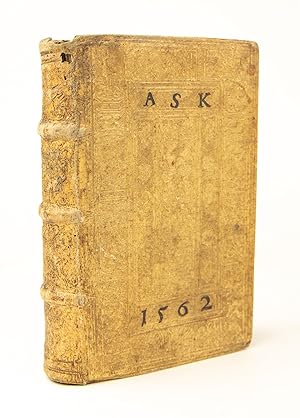Beschreibung
With three divisional title pages, all featuring the Aldine dolphin and anchor device. Bound in contemporary blind-tooled pigskin (lightly soiled, corners bumped, small hole in pigskin at head of spine, wear at extremities), signed "A.S.K." and dated 1562 on the upper board. Title page lightly soiled, intermittent mild foxing, light marginal staining in places. A few manuscript notes and underscores. The binding: decorated with blind-stamped images of Apollo (with harp)and the Muses: Caliope (with zither), Thalia (with lute), Euterpe (with horn), Terpsichore (with viola). The Euterpe stamp is signed "S.N.", that of Terpsichore is dated "1549". The binding is probably the work of the Wittenberg binder Conrad Neidel (active 1542-15602), see Haebler, Vol. I, p. 308. This edition marks the second appearance of the celebrated commentary of Marc Antoine Muret, "the most important commentary on Catullus since that of Parthenius in 1485."(Gaiser). Muret, who had fled France to avoid trial for homosexuality, prepared his commentary while taking refuge in Italy with Paul Manutius. Muret was the first commentator to pair Sappho s Greek poem "Phainetai moi kênos îsos theoisin"(Sappho 31) with Catullus poem 51, "Ille mi par esse deo videtur", which Catullus based on Sappho s poem. "In 1552 Muret lectured on Catullus and other Latin poets in Paris, perhaps at the College du Cardinal Lemoine or the College de Boncourt. Included in his large and enthusiastic audiences were several poets of the Pléiade -most notably Ronsard, his friend and near contemporary. Muret's lectures created a fashion for Catullan poetry. His own neo-Latin collection, Juvenilia (1552), contains several Catullan imitations, but Catullus is still more important in the poetry of the Pléiade, much of which appeared close on the heels of his lectures."(Gaiser) Late in 1553 Muret was forced to leave Paris, where he was persecuted for being a homosexual. Earlier in the year he had been accused of "unnatural vice" and imprisoned at the fortress of Châtelet "and would have died of starvation had his friends not intervened to secure his release. Disgraced at Paris and reduced to poverty, he fled to Toulouse, where he eked out a living by giving lessons in law. He was accused a second time of having committed sodomy, in this instance with a young man named L. Memmius Frémiot, and on the advice of a councilor he absconded once more. He was sentenced to death in absentia and burned in effigy with Frémiot in the Place Saint-Georges as a Huguenot and sodomite. He crossed the Alps in disguise and was warmly received for a time in Venice, while in France his memory was ceaselessly vilified." (Warren Johansson) Soon after arriving in Venice, in May 1554, Muret was befriended by Paul Manutius, who, learning of his enthusiasm for Catullus, persuaded him to produce a commentary. Muret went to work and completed the task in a little less than three months, as he says in the dedication, dated October 15, 1554. "Since Muret had been in Venice only a few months, his commentary on Catullus was no doubt largely drawn from the Paris lectures. His notes display a combination of learning and poetic sophistication that would have appealed to the Pléiade. More than any of his predecessors except Valerianus, he discusses the artistic qualities of Catullus' work and the details of vocabulary and meter that work together to secure an effect. He appends a poem of his own in galliambics to his discussion of the meter in Cat. 63, discusses the appropriateness of the similes in Cat. 68 (which he regards as perhaps the most beautiful elegy in Latin) and discourses on the delight of studying Catullus' translations in close conjunctions with their Greek models. He is the first commentator to print Sappho's poem with Cat. 51 (see folio 57), and he laments the loss of Callimachus' lock of Berenice in the discussion of Cat. 66 and prints all the fragments of that poem known to him. "Muret is interested in th. Bestandsnummer des Verkäufers 4901
Verkäufer kontaktieren
Diesen Artikel melden
![]()




